What’s The Deal With These VR Backpacks?
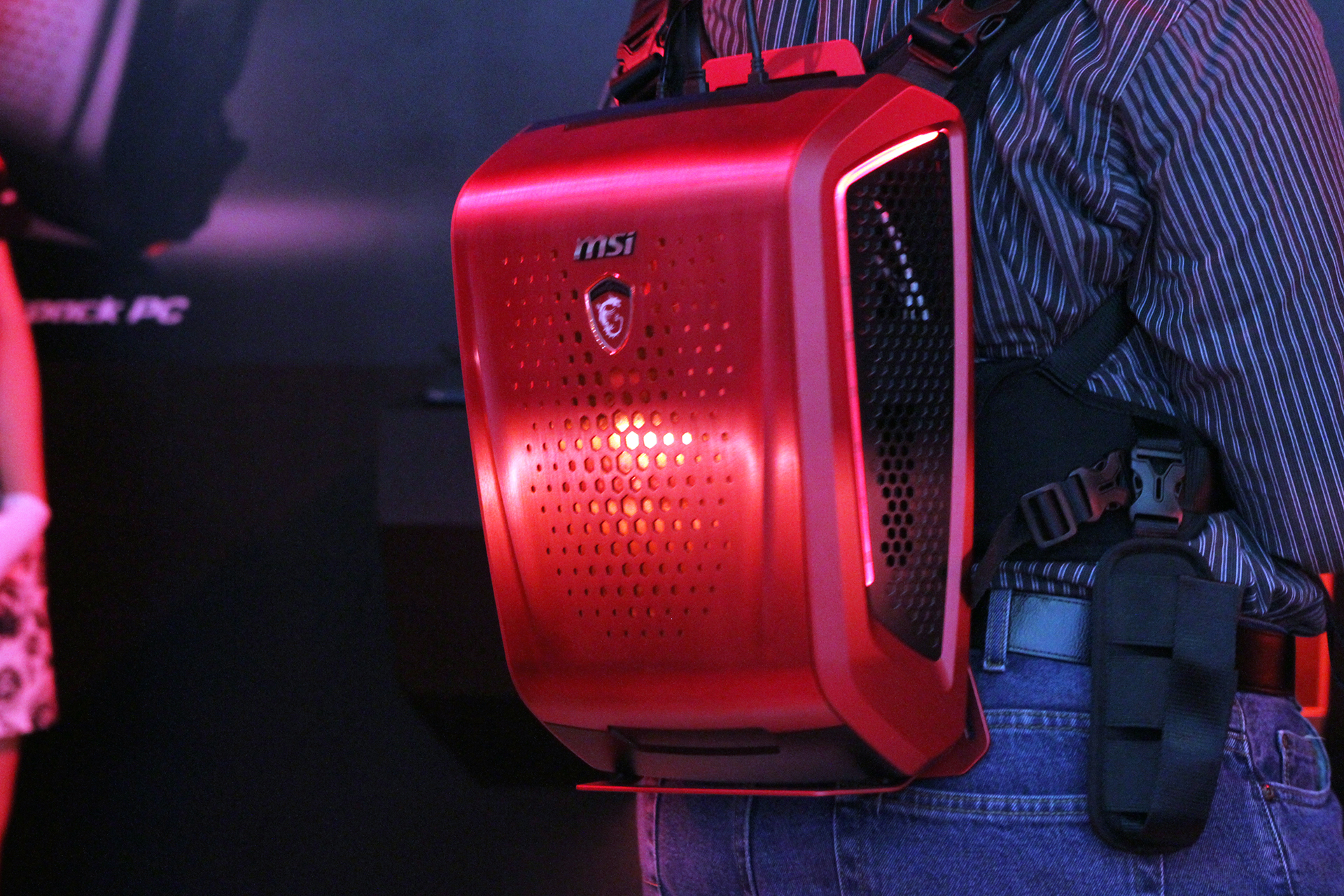
Ahead of Computex 2016, MSI announced that it had a VR backpack to show off. The concept makes sense to a degree, in that instead of being tethered to a PC by a VR HMD’s cables, you would be free to roam a virtual world within your physical one. If the HMDs can’t be wireless, then why not make the PC wireless (in a way), goes the logic.
But because the PC goes on your back, problems emerge--most notably, what sort of otherworldly battery do you need to power a VR-ready PC?
Other more minor but nevertheless problematic issues could arise around cable management and connecting and powering indispensable items such as the HTC Vive’s link box. Going in, we weren’t sure that MSI had thought through all of the above. And then we learned about a couple more VR backpack prototypes.
MSI On Track
MSI had its backpack prominently on display in its enormous, bustling booth, and a few of us had the chance to try it out. Getting geared up was a little bit of a chore; there were two “helpers” strapping me in like I was a scuba diver donning an air tank, although I suspect that was much ado about nothing. You should be able to hoist the VR backpack on your shoulders solo with no problem.
Weight And Heat
During the actual demo, the backpack all but disappeared. I immediately forgot that I was wearing it, focusing instead on the space droid spitting deadly pink orbs at me. It’s a perfect VR demo because the resolution and overall graphics quality are spot on and the game is simple and engaging (shoot the little things before they kill you), and it intensifies as you play. In short order, instead of dodging a few slowly floating pink balls, you have adorable projectiles coming at you from all sides, and you have to hustle to stay alive.
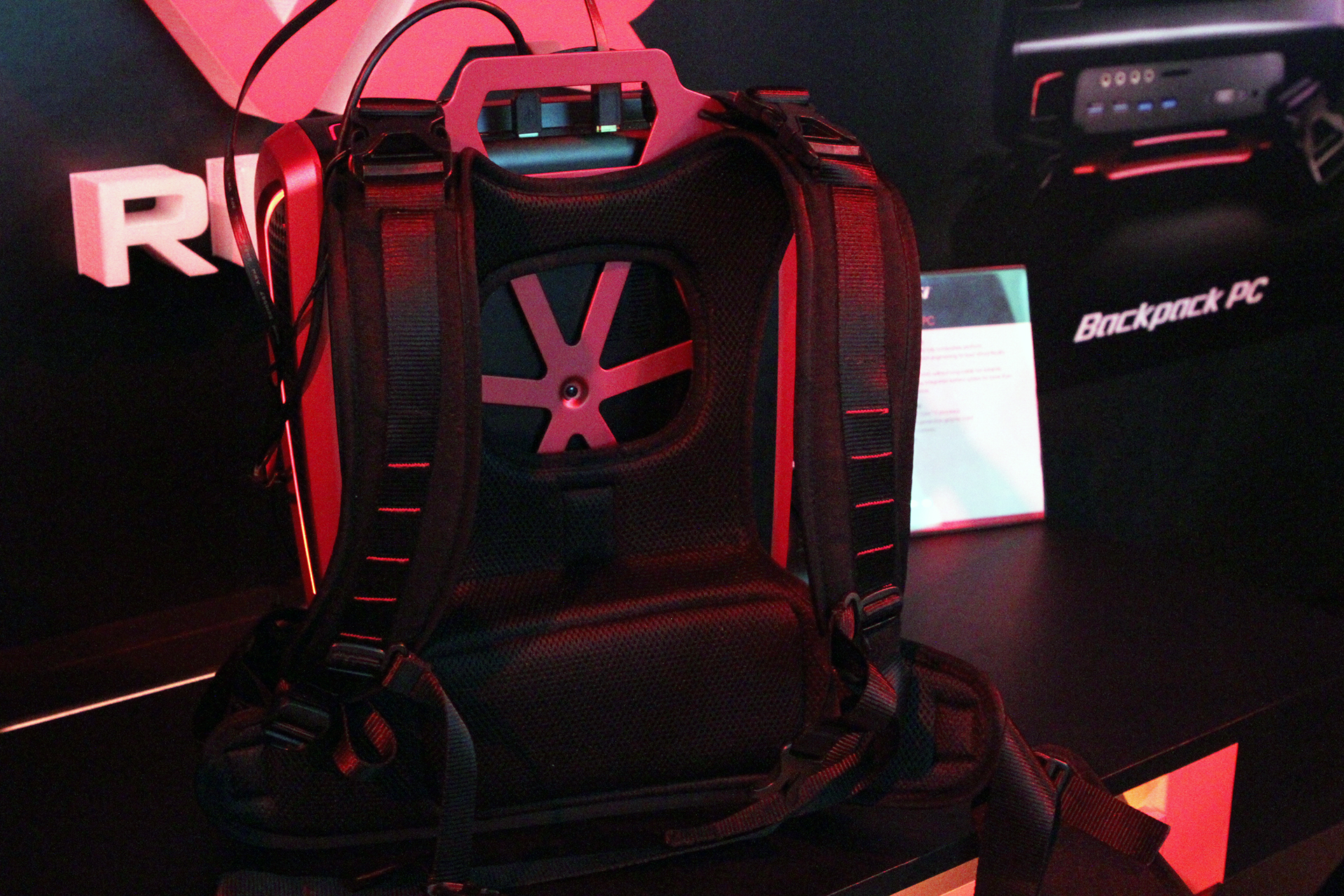
When I couldn’t simply dodge the balls and had to actually squat down to evade the attacks, I remembered that I was wearing the backpack. I was essentially doing squat thrusts with what felt like 15 or so pounds on my back. (MSI said that the final version will weigh “under” 5 kilograms, or about 11 lbs.)
Stay On the Cutting Edge: Get the Tom's Hardware Newsletter
Get Tom's Hardware's best news and in-depth reviews, straight to your inbox.
In addition to the weight, I was concerned about the heat. You are after all literally wearing a PC, and PCs produce heat, especially when the components are thrumming. This is in addition to the fact that you’re wearing a backpack, which could make your back sweaty even without a high-end PC involved.
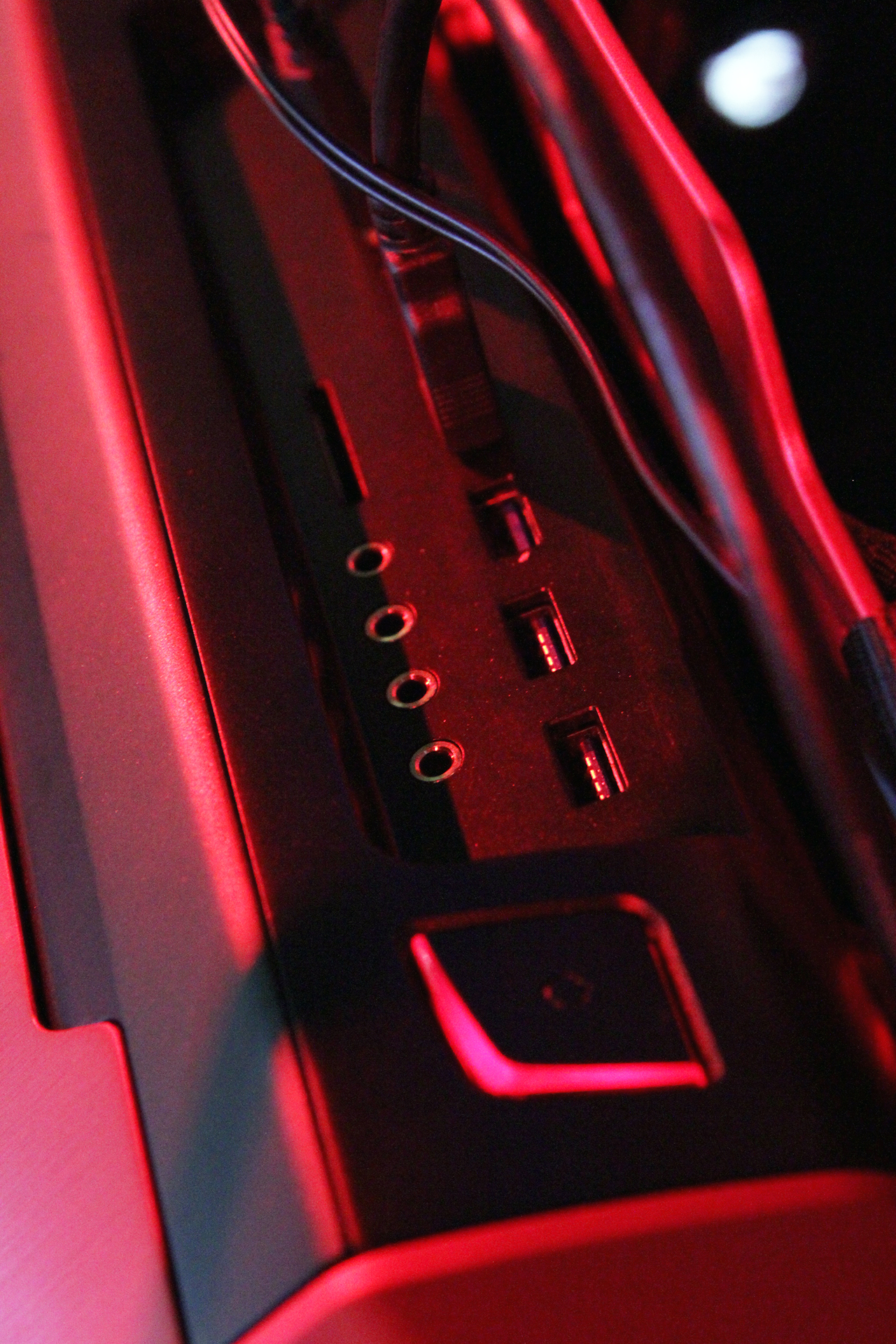
The PC exhausts out the side of the backpack, which is preferable to venting out the top or bottom (for obvious reasons). The area of the booth in which we tested the backpack was partially enclosed and overly warm, so although I was rather toasty by the time I pulled off the HMD, I attribute that mainly to the space itself and not the PC’s heat.
Based on the demo I enjoyed, I believe that wearing this VR backpack will be a reasonably comfortable experience.
Even so, the battery question looms large. On this point, MSI is still making decisions about which type of battery to use, and what capacity, but the demo unit had the same battery as the MSI GT80--Lithium-Ion--but with 24 cells. We have reason to believe that there are three of those 8-cell batteries tucked away into the backpack. Regardless, the final version could be different, and whatever size and type of battery it ends up using, MSI has promised two hours of juice and a faster recharging time when the final version lands on the market sometime in the second half of this year (but closer to Q4).
The backpack also includes an extra port for the Vive’s link box.
Guts, Glory
Under the hood--err, in the backpack--sits an unlocked Intel Core-i7 (mobile) chip. MSI has not yet decided on which GPU will get the nod, but a rep told me that, in the end, they’ll roll with whichever mobile GPU they think can offer the most performance within the limitations of the backpack system. (They’re leaning Pascal.)
We don’t know any other specifications at this time in the way of RAM, storage and so on, but we know that the backpack has 802.11n Wi-Fi that it uses (along with proprietary MSI software) to connect to another PC that can show the VR gameplay on a screen for all to see. (We believe that MSI mocked up this software for demo purposes but possibly saw the value in it for end users.)
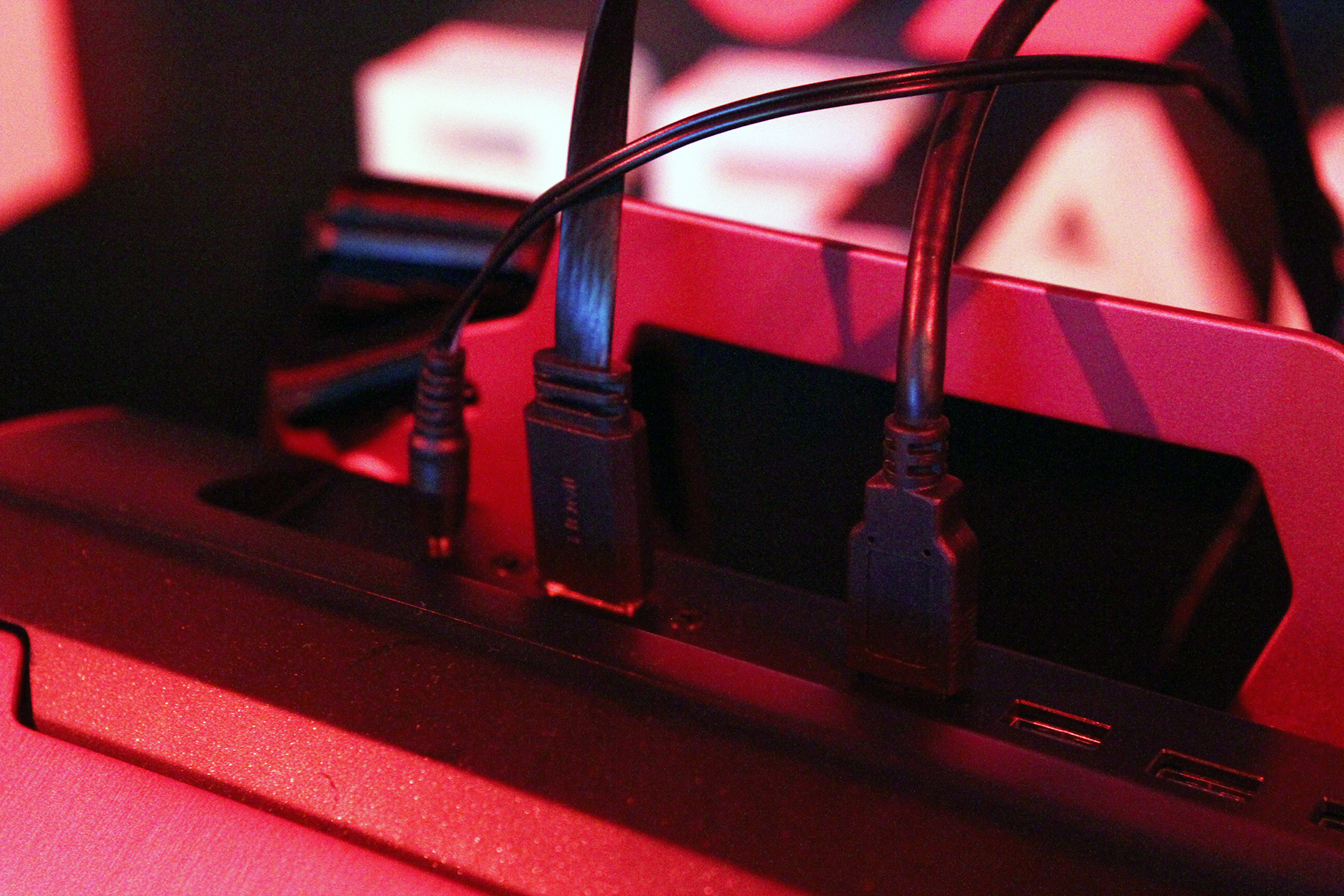
Currently, the VR backpack supports only the Vive, but Rift support is coming. Primarily, because the backpack’s basic job is enabling easier roomscale experiences, there’s no point in supporting the Rift, at least until the Touch controllers finally hit the market. When that happens, MSI reps told me, the backpack would support the Rift.
The Vive has a 5-meter HDMI cable. As anyone who’s ever built a PC knows, that’s a lot of cable to manage. MSI apparently figured that out, because it has worked with HTC to develop a special, shorter (under 50 cm) Vive cable. Ostensibly, the shorter cable is for the MSI VR backpack, but we wonder if HTC would have gone to the trouble unless it thought this VR backpack thing would take off with other companies. It already includes an extra port for the Vive’s link box.
The Others: HP, Zotac, Gigabyte And Chaintek
Speaking of VR backpacks and other companies, MSI is by no means the only one in the game. Although we haven’t seen it yet, HP’s Omen X VR PC Pack looks to be a mostly-developed MSI competitor in this space.
Other prototypes seem less polished. For example, we spotted the below VR backpack from Chaintek.
Chaintek will employ an Nvidia GTX 980 GPU and an Intel Core i7-6700K chip. It was connected to a Vive, and it had three USB ports, one audio connection and two HDMI ports.
As you can see from the images, this prototype is scuffed up and raw, despite the attractive design on the back. Note that the battery pack is basically just a cloth sack at this point. We did get a quick peek inside, though, and found at least two battery packs--and is that a passive heatsink? (How they got this menagerie through airport security is a mystery.)
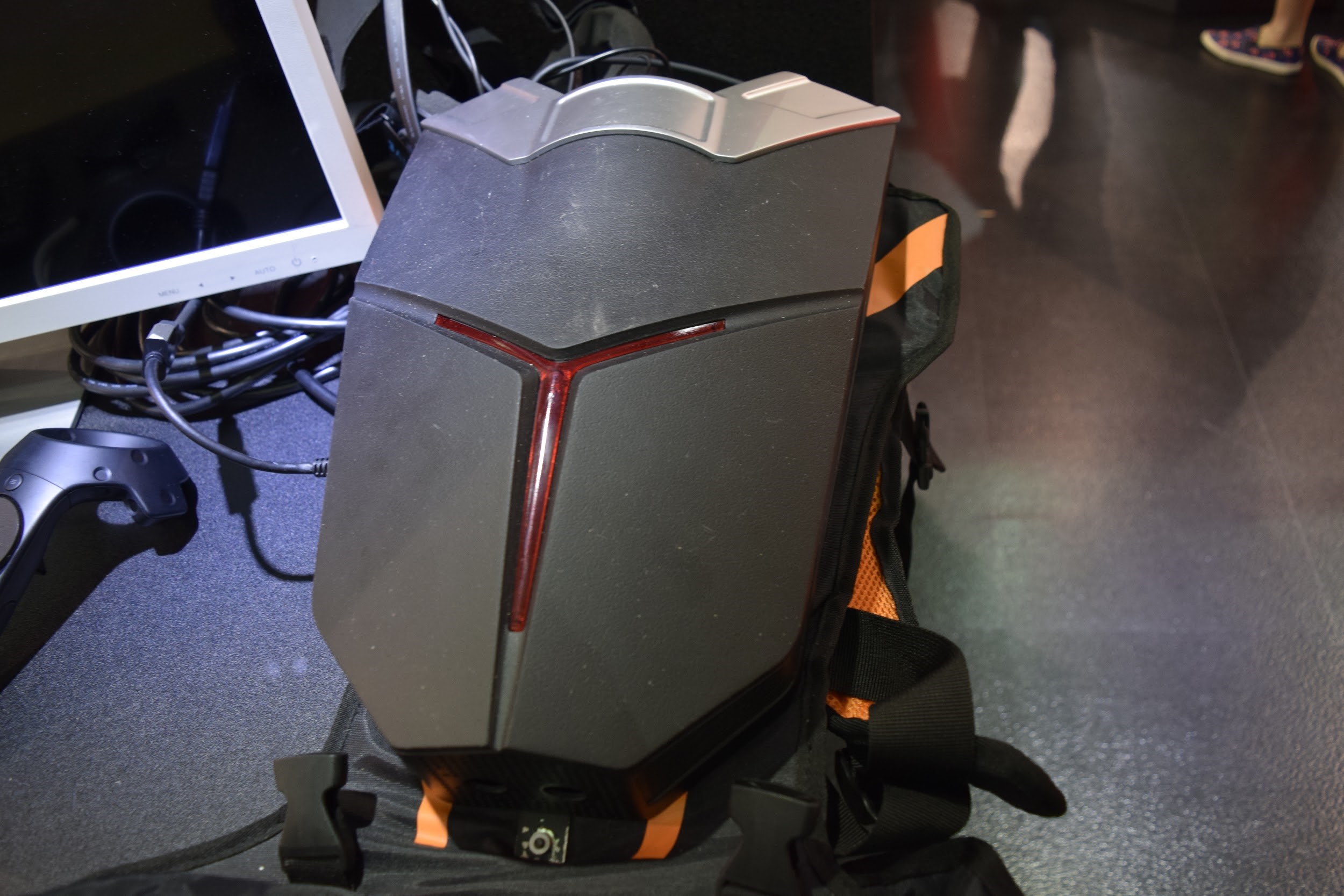
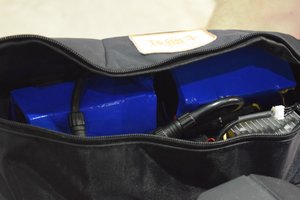
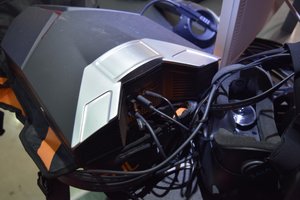
Zotac has its own backpack prototype; this type of product seems almost obvious for a company that specializes in small form factor PCs. In our conversation with company reps, two things were clear: They were doing a good job of thinking through all the issues they needed to solve, and they were not close to finishing that thought process.
For example, they determined that the final version must have a hard shell (like MSI’s backpack) instead of a soft one, to protect the PC from damage when (not if) wearers bump into walls and furniture and friends.
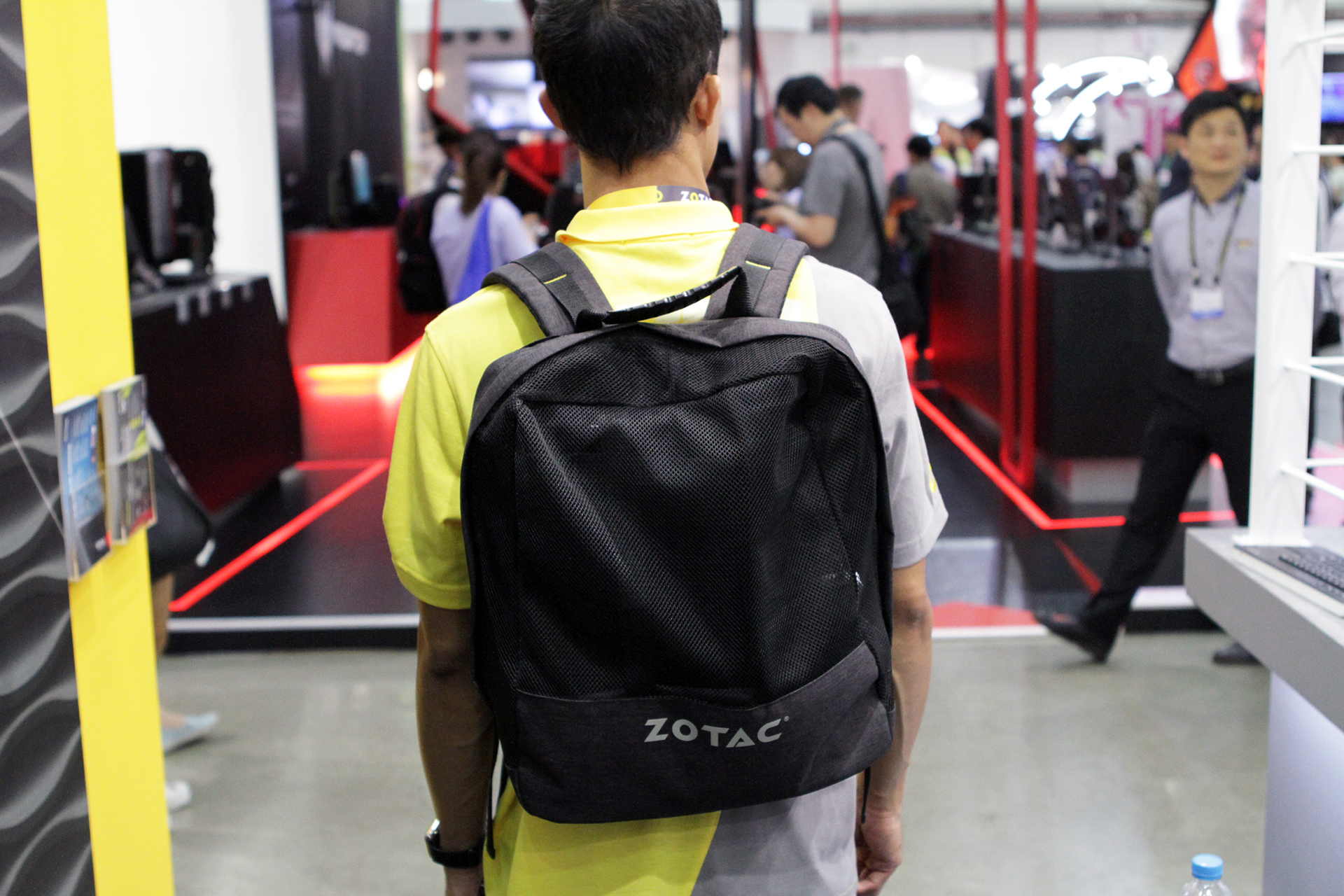
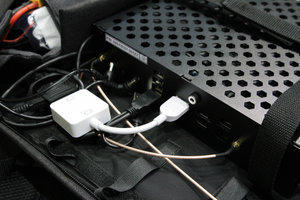
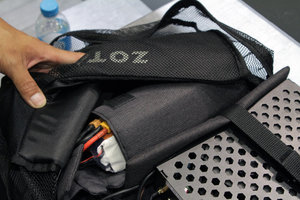
They’re also aware of the thermal problem. The chassis design will have a mesh grill to aid in heat dissipation, and they’ve already developed modified air cooling on a Magnus EN980 mini PC that employs three radial fans. (This is the system that was powering the demos at Zotac’s Computex booth.) All three of Zotac’s EN980 models sport Nvidia GTX 980 GPUs and quad-core Intel Core i5-6400 (Skylake) CPUs. Zotac told me that the chassis has been modified; instead of a mostly square case, the modified EN980 is flatter and wider to fit better on your back.
Zotac also promised that at launch, its backpack would provide up to two hours of battery life.
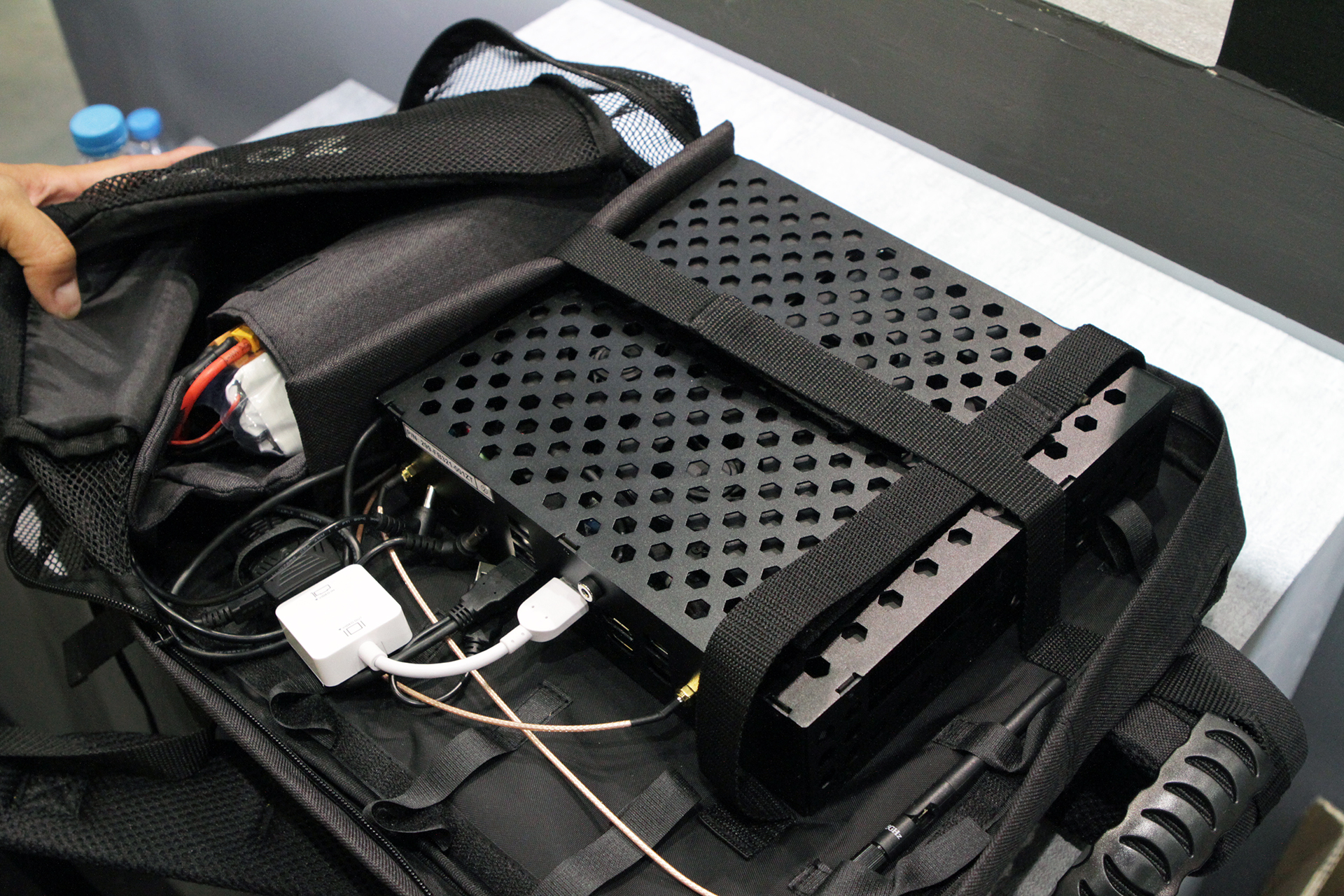
And what of Gigabyte? A direct competitor to MSI, Gigabyte showed off a laptop/backpack setup back at CES. The company has gone dark on it since; there was no sign of it here at Computex, either. One presumes, then, that Gigabyte has abandoned the project (unless it has gone back to the drawing board such that its original idea was scrapped).
To us, the VR backpack concept is one that makes perfect sense at first blush--untethered, high-end VR--but immediately, you bump into ergonomic and technical problems that need to be solved, such as battery life and cooling. Then there’s the realization that you have a full PC on your back, which seems fundamentally odd.
We need to spend significant time with these backpack setups to truly get a sense of whether they’re going to be a boon to living room VR or a clunky fad, but until then: Bring on the VR ideas great and small.
Update, 6/3/16, 6:53am PT: Fixed typo.
Update 2: Also, Alienware has a couple.
Seth Colaner is the News Director for Tom's Hardware. Follow him on Twitter @SethColaner. Follow us on Facebook, Google+, RSS, Twitter and YouTube.
-
It would be cool if these backpacks could blow cool air on the user's back. It's true that carrying a backpack alone can make you sweat, especially in summer.Reply
-
targetdrone ReplyYou don't need a backpack to move around in VR, just get a NerveGear
With all the greifers, cheaters, hackers, and bad devs a NerveGear or Amusphere would suck bad in this world. -
Samer1970 not good for health . heat + radiation/waves for a long time near your internal organs.Reply -
Samer1970 I think they should just add a screen to it and make it notebook desktop replacement at the same time . 2 in one ..Reply -
Haravikk I still don't see the advantage of this over say, getting a small SFX case like a Silverstone Milo, and slapping it on your ceiling.Reply
This way the cable for your VR headset just needs to hang down which should give pretty good freedom of movement; if you can have something in place to make sure the cable sticks out behind you you shouldn't have much risk of getting entangled. -
Samer1970 Reply18067939 said:I still don't see the advantage of this over say, getting a small SFX case like a Silverstone Milo, and slapping it on your ceiling.
This way the cable for your VR headset just needs to hang down which should give pretty good freedom of movement; if you can have something in place to make sure the cable sticks out behind you you shouldn't have much risk of getting entangled.
use spring cables for this ... will expand when you are away from the center .. and will never touch the ground -
rayden54 Reply
What kind of ceiling do you have that this would be viable?18067939 said:I still don't see the advantage of this over say, getting a small SFX case like a Silverstone Milo, and slapping it on your ceiling.
-
mosc Replynot good for health . heat + radiation/waves for a long time near your internal organs.
You seem to have rather oddly forgotten about the 3.828\00d710^26 Watt thermonuclear bomb going off continuously in the sky during the "day". True it is 5.890x 10^12 inches from you but at an intensity that falls off by the square of distance I don't think you should be worrying about heat and radiation from a <1kw backpack. -
Samer1970 Reply18078309 said:not good for health . heat + radiation/waves for a long time near your internal organs.
You seem to have rather oddly forgotten about the 3.828\00d710^26 Watt thermonuclear bomb going off continuously in the sky during the "day". True it is 5.890x 10^12 inches from you but at an intensity that falls off by the square of distance I don't think you should be worrying about heat and radiation from a <1kw backpack.
... even smartphones can hurt your health if you abuse using them . I dont trust putting a pc running full speed for hours near my heart , brain , and kidney ... no matter what they tell me about how safe it is.
my vr machine will be up there on the ceiling ... (soon)